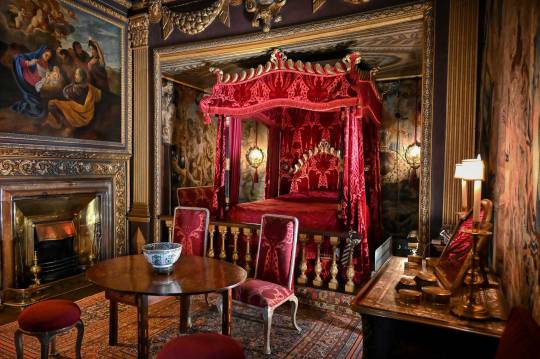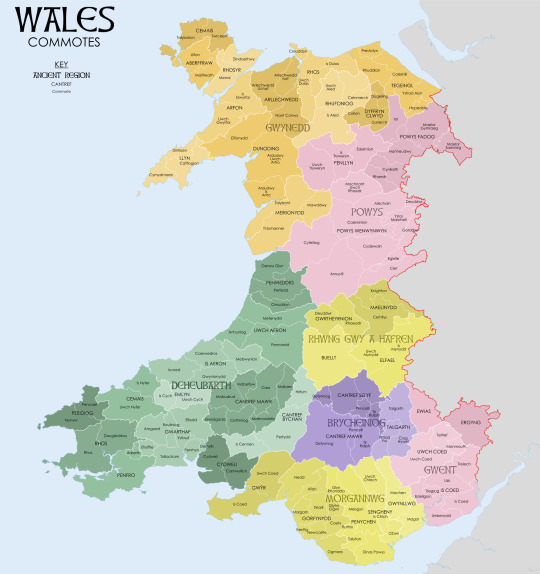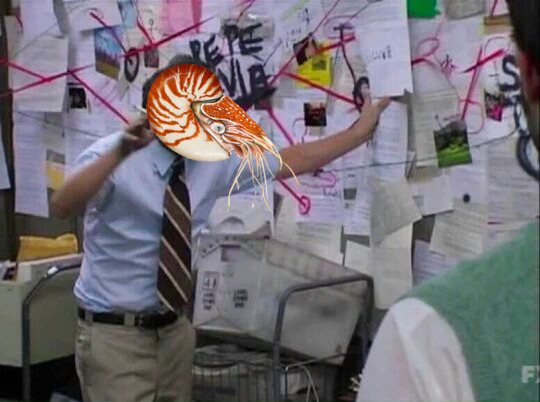#medieval wales
Note
I have watched most of the fandom believe that dorne is a progressive place, and while compare to the rest westeros it is truth, especially when it comes to women inheritance isn't it a bit too much to believe that it is socially progressive as well?
Like, sure for the female elite it much better to live on dorne. But I don't see Doran surround himself and take council with merchants or commonfolk that studied or erudite people.
Am i wrong?
It's true that Doran organizes his government on typical feudal lines, but it's also true that the rank-and-file Dornish, the "Dornish in the street," seem to have a louder and more accepted voice in shaping public opinion than the smallfolk of Westeros.
However, I think when we look to social progressivism in Dorne, our best example is the policies promoted by Sylvenna Sand during the Moon of the Three Kings: using the child Gaemon Palehair as her mouthpiece, Sylvenna promulgated decrees that equalized inheritance between male and female children, mandated a bread and beer dole in times of famine, estabished a crude form of disability insurance for veterans, and punished wife-beaters.
I think this speaks to a broader social progressivism in Dornish culture that goes beyond issues of gender equality to embrace at least a proto-concept of social welfare.
As to whether it's all a bit much to believe, I think GRRM is borrowing from certain histories of the post-1066 wars of expansion that framed Wales as being a more egalitarian society than Norman England, based on certain Welsh legal customs around inheritance, etc.
88 notes
·
View notes
Text

In 1594 Gwen Ferch Ellis was the first person to be executed for witchcraft in Wales. Like most accused female witches, Gwen was previously known to have carried out healing of sick humans and animals in the town of Landyrnog.
Gwen was accused of having a charm written backward; something that was assumed to be a form of bewitching. Gwen was taken to Flint goal to await trial.
During her trial, Gwen was accused of having murdered a man called Lewis ap John through witchcraft and was subsequently found guilty and executed as a witch.
Unlike in England, there were very few witch trials in Wales, with only five executions having taken place. It has been estimated that 500 executions of accused witches had taken place in England during the Early Modern Period.
#witchcraft#witch#witch trials#witch craze#welsh history#medieval wales#medieval history#historyblr#historian#history student#history lover#history buff#welsh witchcraft#welsh witch#occult history#early modern history#early modern wales#tudor wales#tudor britain
9 notes
·
View notes
Text
One of my favorite things about Dafydd ap Gwilym’s poetry is that the man was....I don’t want to say he was straight, because that’s a nigh-impossible call to make on a man who lived the better part of a millennium ago (and whose canon’s been specifically pruned to present a certain image), BUT the majority of his poetry concerns his relationships with women, and yet, overwhelmingly, I’ve had queer scholars mention to me that they feel some kind of connection to it.
Like, this guy openly wrote poetry that said “I don’t think God’s as cruel as people say he is” in the 14th century, about a love affair that wasn’t sanctioned by the law or by the religion of his own time, who openly wrote about feeling like an outcast for this love, meeting with her in secret, and like. It still rings out. And he’s still one of the only figures from the middle ages I’ve ever studied where I feel like he and I could have a nice chat and find some common ground.
25 notes
·
View notes
Text
My new book, Clash of Kings, has a number of main characters. Meet Lady Eadgifu.
My new book, Clash of Kings, has a number of main characters. Meet Lady Eadgifu.
#histfic #NewRelease #ClashOfKings
Clash of Kings has a number of characters, and some might be surprised to find Lady Eadgifu amongst them, but she was an incredibly important historical character, and I couldn’t leave her out of the narrative set at the English court.
Lady Eadgifu was the third wife of Edward the Elder (r.899-924), king of the Anglo-Saxons. Edward the Elder was the father of King Athelstan, and a whole host of…

View On WordPress
#Amazon#Athelstan#Boldwood Books#Clash of Kings#Constantin II of the Scots#Eadgifu#historical fiction#history#Hywel Dda#King of Kings#M J Porter#Medieval Wales#New Release
0 notes
Text

Redwick, Monmouthshire; 6.4.2024
#photography#photographers on tumblr#dubmill#Redwick#Monmouthshire#Wales#UK#Britain#church#architecture#medieval#gothic#cemetery#churchyard#original photography#original photograph#walk#Severn Tunnel Junction to Newport#2024#06042024
156 notes
·
View notes
Text
Thinking about Henry V attending his first parliament as Prince of Wales at 13 years old and being bored out of his skull and imagining how much worse it would've been for Richard II, who attended his first parliament as Prince of Wales at 9 years old.
Thinking about Henry VI attending parliament as a literal infant too.
#verily they should have been in the medieval playground#richard ii#henry v#henry vi#all of this is iirc#i think richard might have just turned up been invested as prince of wales and gone home#and i'm pretty sure hal attended parliament when he was younger (i want to say around 9?) before becoming prince of wales#(possibly with his brother thomas?)#but he could have probably slacked off a lot more then because he wouldn't have quite as on display as the earl of derby's son#blog
82 notes
·
View notes
Text

State Bedroom,
Castell Powys, Welshpool, Powys, Wales.
(c) J.A. Phillips
#art#design#history#style#luxury house#luxury homes#castle#luxurylifestyle#castell#powys castle#state bedroom#bedroom#medieval#wales#national trust
239 notes
·
View notes
Text

The Bard by John Martin
#the bard#john martin#art#romantic#landscape#poem#thomas gray#romanticism#harp#druids#edward i#conquest#wales#britain#england#medieval#middle ages#knights#army#mountains#snowdonia#celtic#welsh#bard#plantagenet#castle#waterfalls#river#conwy#harlech
452 notes
·
View notes
Text

Harlech Castle at sunset. Harlech, Wales.
#harlech castle#castles#wales#united kingdom#travel#architecture#original photography#photographers on tumblr#photography#historical architecture#medieval#middle ages#lensblr#sunset#wanderingjana
20 notes
·
View notes
Text
This video has taught me just how complicated sourcing can be and how easily claims can become misinformation taken as fact. My ability to research and source feels so incredibly inferior. Its a good watch.
#sourcing#resources#research#youtube#I feel i should strive to be MUCH better#welsh history#wales#welsh#henry vii#house of tudor#british#medieval history#Cadwaladr#red dragon#flag of wales
48 notes
·
View notes
Photo

Moody conditions at Castell Dinas Brân, Wales.
#alexmurison#wales#Castell Dinas Brân#castle#history#moody#medieval#photographers on tumblr#original photography#wander#wanderlust#lensblr#walk#walking#hike#hiking#sunset#adventure#explore#explore more#never stop exploring#explore to create#wilderness#wilderness culture#nature#wildlife#tolkien#mood#landscape photography#hills
154 notes
·
View notes
Text
It’s depressing how the Owain Glyndwr tag on here is just filled with content from The Raven Cycle.
3 notes
·
View notes
Quote
We can overlook the objection of the terminological pedants that the Britain of Langtoft’s dream and Edward I’s ambition did not, of course, correspond to the Roman province of Britannia at any point in its history. Much more serious, indeed insuperable, was the fact that power of itself does not automatically entitle the powerful to appropriate a mythology, try as they might. The original owners and sitting tenants of British mythology were still in residence and would lay claim to their inheritance for centuries to come. They were, of course, the Britons, otherwise and latterly known as the Welsh. They stood squarely and stubbornly between the English and the latter’s attempt to appropriate the mythology of the island of Britain.
R.R Davies, The First English Empire: Power and Identities in the British Isles 1093-1343
13 notes
·
View notes
Text
My new book, Clash of Kings, has a number of main characters. Meet Hywel, the king of the Welsh.
My new book, Clash of Kings, has a number of main characters. Meet Hywel, the king of the Welsh. #histfic #newrelease #ClashOfKings #Brunanburh
My new book, Clash of Kings, is a multi-viewpoint novel telling the story of events in Britain from 937-942. I thought it would be good to share details of the historical people my main characters are based on.
My portrayal of Hywel, better known as Hywel Dda (which autocorrect is determined should say Dad), and which means ‘good’ (a unique epithet in Wales), is of course, fictional, but who was…

View On WordPress
#Amazon#Athelstan#Boldwood Books#Clash of Kings#Constantin II of the Scots#historical fiction#history#Hywel Dda#King of Kings#Kings of War#M J Porter#Medieval Wales#New Release
0 notes
Text
Elphael: What's In a Name?
Earlier today, my esteemed comrade @the-unkindled-queen made a post wondering about the etymology of Elphael, Brace of the Haligtree. My initial digging turned up a few Reddit comments where the general consensus was that Elphael has its roots (ha) in Hebrew linguistics, with one interpretation being "Family of God" and another being "Work of God":


Now as a linguist and Bible scholar, I think these are awesome. I love seeing all the languages and cultures that these games draw inspiration from, and the Hebrew connection is a neat contrast with the Haligtree itself, which is linguistically Welsh. Additionally, the connection to Abrahamic faith and Hebrew words for people and acts of God is a nice throughline for the way the game portrays Miquella and St Trina as Messianic protectors of the sick and poor. Add in the spiritual atmosphere of Elphael and the Haligtree (prayer rooms, mausoleums, and altar-like statues of Miquella and Malenia abound), and it's a very pleasing little theory.
Soulsborne and especially Elden Ring borrow heavily from Welsh for names and whatnot (like the aforementioned Haligtree), and out of idle curiosity I began to wonder if there was any basis whatsoever for an alternative theory linking Elphael's name to Welsh. My only reasons for going down this path were the vaguely Celtic sound of the name and the fact that the Haligtree proper has a Welsh name. I didn't find anything like this during the search that led me to the Hebrew theories, and plugging various fragmentations of "Elphael" into a Welsh->English translator didn't spit out anything of value. I was about to throw in the towel when I did what I probably should have done before faffing about with the translator and just searched "Elphael Welsh."
And oh golly do we have ourselves an Elphael. Or an Elfael.
Welcome to the infinitely confusing world of medieval Welsh history.
Medieval Wales was divided into several regions, called cantrefi. Each cantref was further divided into several territories called commotes. The cantrefi are pictured below. We're mostly concerned with the central yellow one, Rhwng Gwy a Hafren, but also remember Gwynedd. It's in orange up top.

But that's for later. What we care about right now is the cantref of Rhwng Gwy a Hafren, which lies between the rivers Wye and Severn. This cantref is shown in detail below and is home to the commote of Elfael, shown in green. Also take note of Maelienydd and Buellt. They're light blue and yellow respectively, and we're going to need them later.

The history of Elfael is short and confusing, as one can expect from a fiefdom straddling the English-Welsh border during the post-Roman and post-Norman Conquest years. It didn't exist as a political entity for very long (it was only independent from 1155ish to about 1215 before dissolving completely in 1309), and changed hands often during its lifetime.
Our story begins with a man named Elystan Glodrydd, Prince of Buellt. He lived from 950 to 1010 CE, and at some point during his later life he conquered a territory called Ferlix, which was composed of Elfael and Maelienydd. When Elystan died, rulership of Buellt (Ferlix included) passed to his son Cadwgan, and then to Cadwgan's son Idnerth when he died.
Idnerth's reign is remarkable because he's the guy who lost Buellt. An Anglo-Norman noble, Philip De Braose, had conquered basically all the land between the Wye and Severn, which of course included Buellt. For some reason, at the conclusion of his conquest De Braose gave Ferlix back to Idnerth, but kept Buellt for himself. The end result being that Idnerth had gotten kicked out of his grandpa's commote and into what had originally been a conquered vassal territory. Once Idnerth died (presumably in shame), Ferlix went to his son, a man with the astoundingly awesome name of Madog. During this time, the Anarchy was starting.
The Anarchy was a civil war in Britain from 1138 to 1153. King Henry I died in 1135, and his heiress, the Empress Matilda, had many enemies who didn't want her to take the throne. In 1130, a castle had been built in southern Ferlix by one of these enemies, an Anglo-Norman named Pain FitzJohn, Sheriff of Hereford. This is the actual best name in this story. Pain FitzJohn is a fucking badass name. This castle, which was of course called Pain's Castle, was acquired by Madog in 1135 under foggy pretenses. It's likely that Pain wanted Madog's protection from Matilda, but we're not sure.
Old Madog knew that getting a castle called Pain's Castle was an achievement that couldn't be topped, and proceeded to die at age 65 in 1140, secure in the knowledge that he was better than Idnerth. He left five sons, who bucked the trend of going to war for their dead dad's land by dividing Ferlix amongst themselves. Unfortunately for them, this is when the Anarchy caught up with them. Another Norman lord, Hugh De Mortimer, invaded Ferlix in 1142. Two of Madog's sons (Hywel and another Cadwgan) were killed, and in 1146 De Mortimer killed a third son, Maredudd, in the process of capturing Pain's Castle. In 1155, Matilda's son Henry II took the throne of England, and when Hugh De Mortimer protested, Henry kicked him out of Ferlix. This left Madog's two surviving sons, Einion Clud and Cadwallon, to pick up the pieces. These guys hated each other, and neither brother could stomach ruling in consort with the other. But for some reason, they didn't kill each other, instead dividing Ferlix again in two. Cadwallon got the northern part, which came to be called Maelienydd, and Einion Clud got the southern part, which was called Elfael.
Einion Clud and Cadwallon still hated each other, and their realms were openly hostile, each brother still believing he was entitled to sole rule of all that had once been Ferlix. (Again, why didn't they just fight to the death like every other medieval family?) Things came to a head in 1160, when Cadwallon kidnapped Einion Clud and sent him in chains to Owain Gwynedd, the aptly-named King of Gwynedd, who in turn pawned him off on King Henry II. Eventually, Einion Clud either escaped or was released. It's not certain which of these occurred, but what is certain is that by 1165, Einion Clud was once again ruling Elfael, and at the Battle of Corwen the two brothers fought together against King Henry under the leadership of Owain Gwynedd. Politics are fucking weird.
There would be no happy ending, however. Hugh De Mortimer's son Roger was swearing revenge on his father's enemies. You might take this to mean King Henry, who kicked Hugh De Mortimer out of Ferlix in 1155, but no, Roger was actually a big fan of Henry II and had fought for the King during the Revolt of 1173. No, Roger wanted revenge on the guys who ruled Ferlix after his dad got yanked. The timeline here is a bit weird, but what's certain is that Roger De Mortimer killed Cadwallon in 1179. He also killed Einion Clud, but I wasn't able to find out when. I found a source saying that Roger killed Einion Clud after his father died, but Hugh De Mortimer died in 1181 and my reading on Cadwallon says that he was the prince of both Maelienydd and Elfael at the time of his death, which would only be possible if Einion Clud died before 1179. In fact, Cadwallon is said to have been ambushed by Roger's men in Elfael.
Anyway, that's all the history we care about for our purposes. Maybe I'm reading too much into things, but the fact that medieval Wales has the Lord of Elfael getting kidnapped by his brother seems a bit on the nose.

In Welsh history, the Anarchy leaves three of Madog's sons dead and the survivors are on opposing feudal factions. The Lord of Elfael is kidnapped by his brother.
In Elden Ring, the death of Marika's son sparks the Shattering, turning every remaining demigod against each other. The Lord of Elphael is kidnapped by his brother.
Either Miyazaki and Germ are fucking Super Saiyan level Welsh history scholars, or this is just an absurd coincidence. Either way, it's cool.
(tiny sidenote: this part is DEFINITELY conspiracy, but isn't it funny that our kidnapped lord has a sibling who rules Maelienydd??? Doesn't that sound a bit like... Malenia??? Obviously Malenia doesn't do the kidnapping in ER, but the names line up a bit too well...)
Sorry Niko, this is way more than you bargained for.
#elden ring#wales#welsh history#medieval history#elden ring lore#miquella the unalloyed#mohg the omen#malenia blade of miquella#the shattering#queen marika the eternal
61 notes
·
View notes